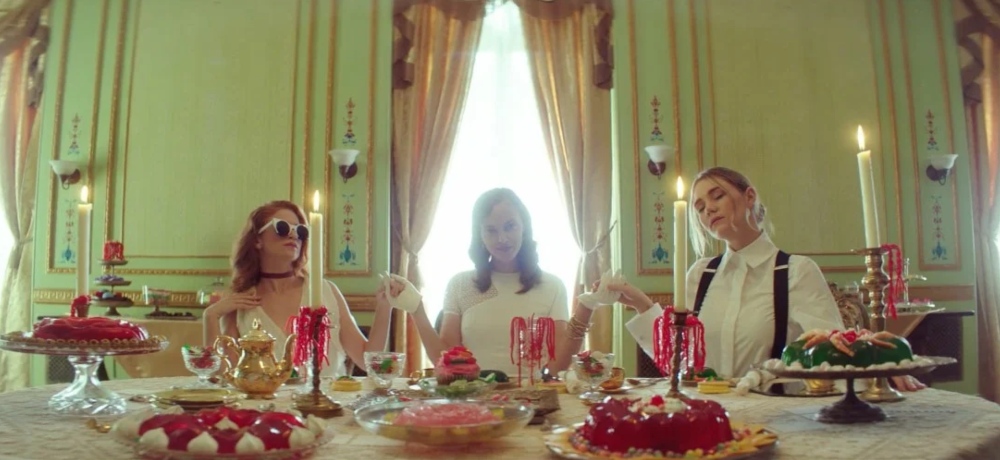


I first saw Braid (aka Dying to Play) at the North Bend Film Festival in 2018. I immediately loved it. The colors, the story, the bizarreness of it all was right up my alley. But there was something else about it that really struck me. It was something I couldn’t quite define, but it made me comfortable. I felt safe with it, in a strange way.
It was only later when I saw Greta Gerwig’s phenomenal adaptation of Little Women that I made the connection and figured it out. The March sisters create a space where they can be completely themselves. They are loud and boisterous and free from societal constraints. It’s a space where they can simply exist. And it is THEIRS.
In her film, Mitzi Peirone creates a similar space for her trio of characters. Sure, it’s a little more violent and murderous than the March house, but that’s part of the charm, too. And as a lifelong horror nerd, it’s something that intrigued me.
When a drug opportunity goes south and the police show up at their apartment, Petula (Imogen Waterhouse) and Tilda (Sarah Hay) escape and head to the home of their childhood friend and heiress, Daphne (Madeline Brewer). Their intent is to search the palatial manor for a safe that houses thousands of dollars in cash, and then use that money to pay back the drug dealer for the lost product that the police seized.
However, this plan has a snag: Daphne is a tad unstable, and the only way to gain entry to the estate is to play a game that they have been playing since childhood. They will all assume their roles and act their parts, and three rules must be followed at all times: (1) everyone must play, (2) no outsiders, and (3) nobody leaves.
As the story progresses, the world of the film becomes increasingly fragile. Time seems to move strangely, violence is done and then undone, and little by little, the outside world seems to fall away. As the girls become more comfortable in their respective roles, the space around them seems to shift and further reflect the imaginary world that they have created.
Peirone speaks to the nature of reality on the Switchblade Sisters podcast:
I made Braid as a form of artistic manifesto, this visual poem to explain that reality is an extension of our thoughts. If you think about it, everything in our society is invented: our jobs, our names, politics, society in general, even time… so what separates us from kids playing make-believe? Nothing. We’ve constructed this global sandbox and we validate ourselves into what we think we are by repeating our actions over and over…”
So, if everything in our reality is made, it can be unmade. It can be changed and altered based on the desires and whims of these characters. They can go from a world where the rules of society are overpowering and instead exist in a world that allows them to breathe. As Peirone continued to explain on the Switchblade Sisters podcast:
Within the make-believe, everything is possible. Patula can be a doctor, Tila can be this… bratty 12-year-old girl. And Daphne, who's barren in real life, she plays the mother. So, they’re all… fulfilling their unfulfilled needs within the world of make-believe.
They have created a space solely for themselves. It’s a space that twists elements of their childhood imaginations into adult forms. They exist as their adult selves, but they continue to inhabit the pretend roles that they played as children. They have tea parties where massive cupcakes are served alongside gummy worms and candy. The world takes on strange colors because they make it so. They skip about in the garden at all hours of the day and fall asleep in a beautiful blanket fort. Time means nothing and neither does the outside world. Because does it even exist? It’s equally possible that the story begins in the “real” world and transitions to a world of the girls’ imaginations, or that everything that we’re seeing could be cycling through this world that they created. Maybe none of it is “real” at all. Or maybe it all is.
One of the things that makes Braid feel so unique is the fact that it doesn’t eschew the traditional rules and put in place a new set. Peirone doesn’t unmake the world simply to create another in its place. The space that these girls inhabit is one free of rules and boundaries. It simultaneously exists within the real world while also being separate from it. And on top of it. It’s here and it’s there. We can be wounded one moment and completely healed the next. We can be adults and children at the same time. We can be killed. Sometimes death isn’t the end of us, and other times it is.
It may feel nonsensical at times, but perhaps that is the point, to deconstruct the building blocks of society and replace them with what these women deem to be important and fanciful. If each of us were to create a reality of our choosing, how many of them would rely on structure and how many would embrace a lack of structure and the freedom to simply be?
Whatever the structure (or lack thereof) of the world within Braid, it is one that is made as a feminine space—a space created by and for women. And to a female audience, that in itself feels safe and special. It invites us into the minds of these characters and into their games and gives them the freedom to exist as they see fit, unburdened by the rules of a patriarchal society and free to just BE in any way they feel comfortable. To experience that, even as an outside viewer, is magical.
---------
Go HERE to catch up on all of our Indie Horror Month 2022 features!